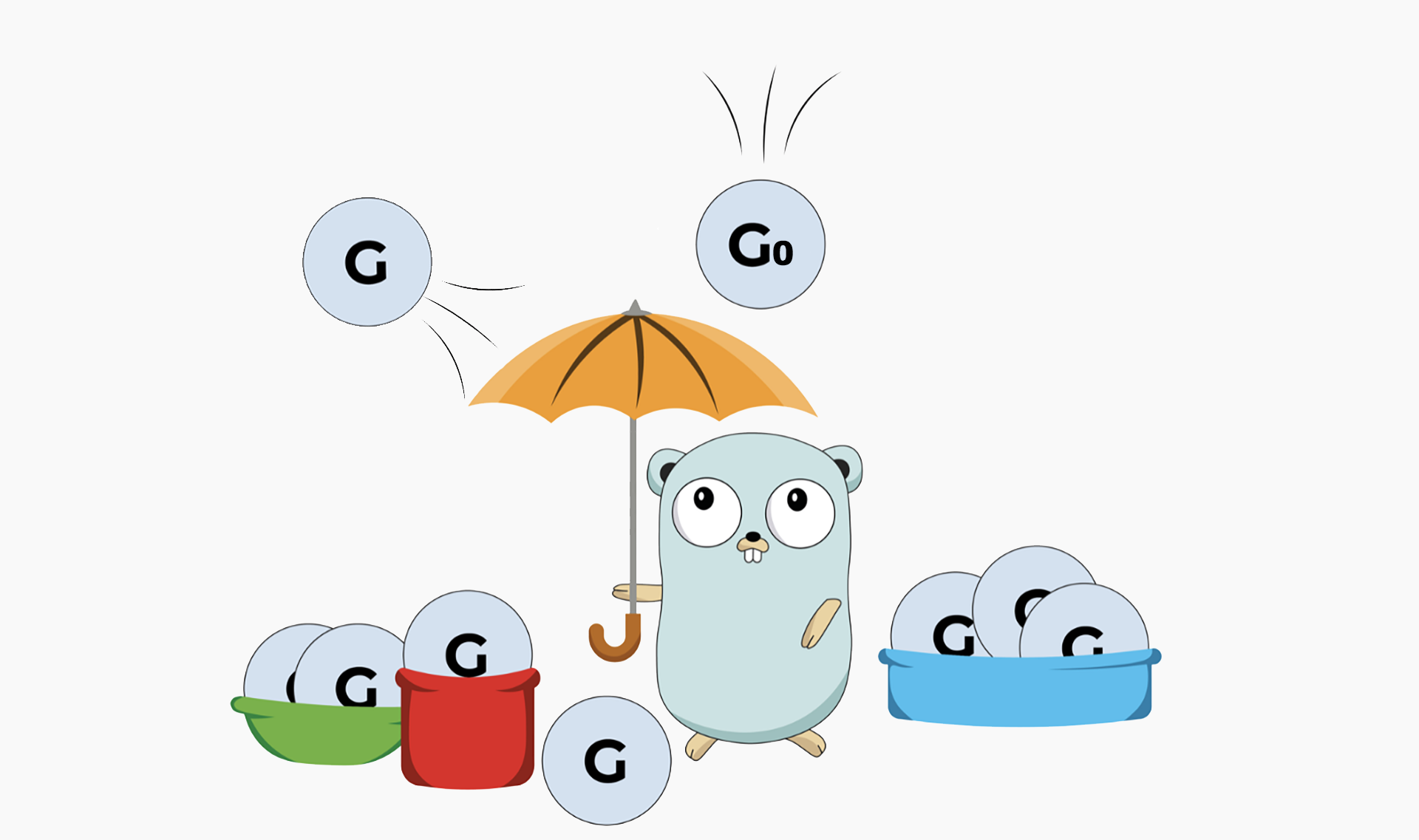Go Channel 浅析 —— 基本操作的底层实现
CSP
Go Channel 采用 CSP 模型,CSP(通信顺序进程,Communicating Sequential Processes)是一种用于描述并发系统的模型。它由英国计算机科学家 Tony Hoare 在1978年提出。CSP 提出一种通过消息传递(而非共享内存)进行进程间通信的方式,这种方式使并发编程变得更为直观且易于理解。Go 语言的并发原语 goroutine 和 channel 就是受到了 CSP 模型的启发。
数据结构
// channel 数据结构
type hchan struct {
qcount uint // 当前队列中剩余元素个数
dataqsiz uint // 环形队列长度,即可以存放的元素个数
buf unsafe.Pointer // 环形队列指针
elemsize uint16 // 每个元素的大小
closed uint32 // 标识关闭状态
timer *timer // channel 关联的 timer
elemtype *_type // 元素类型
sendx uint // 队列下标,指示元素写入时存放到队列中的位置
recvx uint // 队列下标,指示元素从队列的该位置读出
recvq waitq // 等待读消息的goroutine队列
sendq waitq // 等待写消息的goroutine队列
lock mutex // 互斥锁,chan不允许并发读写
}
// waitq 存储了分别指向队头和队尾两个 runtime.sudog 的指针以构成链表
type waitq struct {
first *sudog
last *sudog
}
基础操作
创建 Channel
Go 语言中所有 Channel 的创建都会使用 make 关键字。编译器会将 make(chan int, 10) 表达式转换成 OMAKE 类型的节点,并在类型检查阶段将 OMAKE 类型的节点转换成 OMAKECHAN 类型。这一阶段会对传入的缓冲区大小进行检查,如果我们不传递表示缓冲区大小的参数,那么就会设置一个默认值 0,也就是当前的 Channel 不存在缓冲区。OMAKECHAN 类型的节点最终都会在 SSA 中间代码生成阶段之前被转换成直接或间接调用 runtime.makechan 函数。
func makechan(t *chantype, size int) *hchan {
elem := t.Elem
// 部分前置检查
...
// 计算所需内存空间
mem, overflow := math.MulUintptr(elem.Size_, uintptr(size))
if overflow || mem > maxAlloc-hchanSize || size < 0 {
panic(plainError("makechan: size out of range"))
}
var c *hchan
switch {
case mem == 0:
// Queue or element size is zero.
c = (*hchan)(mallocgc(hchanSize, nil, true))
// Race detector uses this location for synchronization.
c.buf = c.raceaddr()
case !elem.Pointers():
// Elements do not contain pointers.
// Allocate hchan and buf in one call.
c = (*hchan)(mallocgc(hchanSize+mem, nil, true))
c.buf = add(unsafe.Pointer(c), hchanSize)
default:
// Elements contain pointers.
c = new(hchan)
c.buf = mallocgc(mem, elem, true)
}
c.elemsize = uint16(elem.Size_)
c.elemtype = elem
c.dataqsiz = uint(size)
lockInit(&c.lock, lockRankHchan)
...
return c
}
makechan 会根据传入的类型和缓冲区长度来决定如何对内存空间进行初始化:
- 如果当前传入的 Channel 缓冲区长度为 0,或类型占用空间为 0,那么就只会为
runtime.hchan分配一段内存空间; - 如果当前 Channel 中存储的类型不是指针类型,会为当前的 Channel 和底层的数组分配一块连续的内存空间;
- 非上述两种情况会单独为
runtime.hchan和缓冲区分配内存;
发送数据
程序代码中通过 ch <- elem 语句向 Channel 发送数据,编译器会将该原语解析成 OSEND 类型的节点,并最终转换成调用 chansend 函数。
- 检查 Channel 是否已经关闭,向已关闭的 Channel 发送数据会引发 Panic:
func chansend(c *hchan, ep unsafe.Pointer, block bool, callerpc uintptr) bool { ... if c.closed != 0 { unlock(&c.lock) panic(plainError("send on closed channel")) } ... } - 检查是否有处于等待队列中的消费者,如有则直接发送数据:
func chansend(c *hchan, ep unsafe.Pointer, block bool, callerpc uintptr) bool { ... if sg := c.recvq.dequeue(); sg != nil { // Found a waiting receiver. We pass the value we want to send // directly to the receiver, bypassing the channel buffer (if any). send(c, sg, ep, func() { unlock(&c.lock) }, 3) return true } } - 检查当前缓冲区的元素个数是否小于缓冲区大小,如果仍有空间,则将元素写入缓冲区:
func chansend(c *hchan, ep unsafe.Pointer, block bool, callerpc uintptr) bool { ... if c.qcount < c.dataqsiz { // Space is available in the channel buffer. Enqueue the element to send. qp := chanbuf(c, c.sendx) if raceenabled { racenotify(c, c.sendx, nil) } typedmemmove(c.elemtype, qp, ep) c.sendx++ if c.sendx == c.dataqsiz { c.sendx = 0 } c.qcount++ unlock(&c.lock) return true } ... } - 非阻塞发送,直接返回:
func chansend(c *hchan, ep unsafe.Pointer, block bool, callerpc uintptr) bool { ... if !block { unlock(&c.lock) return false, false } ... } - 不满足上述条件,Goroutine 将被休眠直至被唤醒:
func chansend(c *hchan, ep unsafe.Pointer, block bool, callerpc uintptr) bool { ... // Block on the channel. Some receiver will complete our operation for us. gp := getg() mysg := acquireSudog() mysg.releasetime = 0 if t0 != 0 { mysg.releasetime = -1 } // No stack splits between assigning elem and enqueuing mysg // on gp.waiting where copystack can find it. mysg.elem = ep mysg.waitlink = nil mysg.g = gp mysg.isSelect = false mysg.c = c gp.waiting = mysg gp.param = nil c.sendq.enqueue(mysg) // Signal to anyone trying to shrink our stack that we're about // to park on a channel. The window between when this G's status // changes and when we set gp.activeStackChans is not safe for // stack shrinking. gp.parkingOnChan.Store(true) gopark(chanparkcommit, unsafe.Pointer(&c.lock), waitReasonChanSend, traceBlockChanSend, 2) ... }
接收数据
程序代码中通过 elem := <-ch 语句从 Channel 接收数据,编译器会将该原语解析成 ORECV 类型的节点,并最终转换成调用 chanrecv 函数。
- 从
nilChannel 接收数据,非阻塞情况下直接返回,阻塞情况下会直接调用runtime.gopark让出执行权,进入休眠。func chanrecv(c *hchan, ep unsafe.Pointer, block bool) (selected, received bool) { ... if c == nil { if !block { return } gopark(nil, nil, waitReasonChanReceiveNilChan, traceBlockForever, 2) throw("unreachable") } } - 当 channel 为非阻塞模式且 channel 为空时,会进行以下检查,且全程为无锁操作:
- 检查 channel 是否已经关闭。如果 channel 没有关闭,则直接返回,表示接收操作不能继续。
- 如果 channel 已经关闭,则再次检查 channel 是否为空。如果 channel 为空,则表示 channel 已经关闭且没有任何待接收的数据,会清空接收缓冲区并返回
true, false,表示接收操作不能继续
func chanrecv(c *hchan, ep unsafe.Pointer, block bool) (selected, received bool) { ... // Fast path: check for failed non-blocking operation without acquiring the lock. if !block && empty(c) { // After observing that the channel is not ready for receiving, we observe whether the // channel is closed. // // Reordering of these checks could lead to incorrect behavior when racing with a close. // For example, if the channel was open and not empty, was closed, and then drained, // reordered reads could incorrectly indicate "open and empty". To prevent reordering, // we use atomic loads for both checks, and rely on emptying and closing to happen in // separate critical sections under the same lock. This assumption fails when closing // an unbuffered channel with a blocked send, but that is an error condition anyway. if atomic.Load(&c.closed) == 0 { // Because a channel cannot be reopened, the later observation of the channel // being not closed implies that it was also not closed at the moment of the // first observation. We behave as if we observed the channel at that moment // and report that the receive cannot proceed. return } // The channel is irreversibly closed. Re-check whether the channel has any pending data // to receive, which could have arrived between the empty and closed checks above. // Sequential consistency is also required here, when racing with such a send. if empty(c) { // The channel is irreversibly closed and empty. if raceenabled { raceacquire(c.raceaddr()) } if ep != nil { typedmemclr(c.elemtype, ep) } return true, false } } } - 如果当前 Channel 已经被关闭并且缓冲区中不存在任何数据,那么会清除
ep指针中的数据并立刻返回。func chanrecv(c *hchan, ep unsafe.Pointer, block bool) (selected, received bool) { ... if c.closed != 0 { if c.qcount == 0 { if raceenabled { raceacquire(c.raceaddr()) } unlock(&c.lock) if ep != nil { typedmemclr(c.elemtype, ep) } return true, false } // The channel has been closed, but the channel's buffer have data. } ... } - 如果 Channel 未关闭且仍有等待的发送者,则:
- 当存在等待的发送者时,通过
runtime.recv从阻塞的发送者或者缓冲区中获取数据; - 如果 Channel 缓冲区大小为 0:调用
runtime.recvDirect将 Channel 发送队列中 Goroutine 存储的elem数据拷贝到目标内存地址中; - 如果 Channel 缓冲区大小不为 0:则将队头中的数据拷贝到接收方的内存地址,将发送队列头的数据拷贝到缓冲区中,同时唤醒该发送方先前休眠的 Goroutine;
func chanrecv(c *hchan, ep unsafe.Pointer, block bool) (selected, received bool) { ... if c.closed != 0 { ... } else { // Just found waiting sender with not closed. if sg := c.sendq.dequeue(); sg != nil { // Found a waiting sender. If buffer is size 0, receive value // directly from sender. Otherwise, receive from head of queue // and add sender's value to the tail of the queue (both map to // the same buffer slot because the queue is full). recv(c, sg, ep, func() { unlock(&c.lock) }, 3) return true, true } } ... } func recv(c *hchan, sg *sudog, ep unsafe.Pointer, unlockf func(), skip int) { // 缓冲区大小为 0 // 调用 recvDirect 直接接收 if c.dataqsiz == 0 { if raceenabled { racesync(c, sg) } if ep != nil { // copy data from sender recvDirect(c.elemtype, sg, ep) } } else { // 缓冲区大小不为 0 // Queue is full. Take the item at the // head of the queue. Make the sender enqueue // its item at the tail of the queue. Since the // queue is full, those are both the same slot. qp := chanbuf(c, c.recvx) if raceenabled { racenotify(c, c.recvx, nil) racenotify(c, c.recvx, sg) } // 从缓冲区拷贝队头数据给接收者 if ep != nil { typedmemmove(c.elemtype, ep, qp) } // 从发送者拷贝数据到缓冲区队尾 typedmemmove(c.elemtype, qp, sg.elem) c.recvx++ if c.recvx == c.dataqsiz { c.recvx = 0 } c.sendx = c.recvx // c.sendx = (c.sendx+1) % c.dataqsiz } sg.elem = nil gp := sg.g unlockf() gp.param = unsafe.Pointer(sg) sg.success = true if sg.releasetime != 0 { sg.releasetime = cputicks() } goready(gp, skip+1) } - 当存在等待的发送者时,通过
- 如果 Channel 未关闭且发送等待队列中没有等待发送的发送者,但缓冲区有数据,则直接从缓冲区中获取数据。
func chanrecv(c *hchan, ep unsafe.Pointer, block bool) (selected, received bool) { ... if c.qcount > 0 { // Receive directly from queue qp := chanbuf(c, c.recvx) if raceenabled { racenotify(c, c.recvx, nil) } if ep != nil { typedmemmove(c.elemtype, ep, qp) } typedmemclr(c.elemtype, qp) c.recvx++ if c.recvx == c.dataqsiz { c.recvx = 0 } c.qcount-- unlock(&c.lock) return true, true } ... } - 不满足上述所有情况下,非阻塞模式接收将直接返回,阻塞模式的接收者将被加入等待队列,进入休眠等待的状态,等待被新发送的消息唤醒。
func chanrecv(c *hchan, ep unsafe.Pointer, block bool) (selected, received bool) { ... if !block { unlock(&c.lock) return false, false } // no sender available: block on this channel. gp := getg() mysg := acquireSudog() mysg.releasetime = 0 if t0 != 0 { mysg.releasetime = -1 } // No stack splits between assigning elem and enqueuing mysg // on gp.waiting where copystack can find it. mysg.elem = ep mysg.waitlink = nil gp.waiting = mysg mysg.g = gp mysg.isSelect = false mysg.c = c gp.param = nil c.recvq.enqueue(mysg) if c.timer != nil { blockTimerChan(c) } // Signal to anyone trying to shrink our stack that we're about // to park on a channel. The window between when this G's status // changes and when we set gp.activeStackChans is not safe for // stack shrinking. gp.parkingOnChan.Store(true) gopark(chanparkcommit, unsafe.Pointer(&c.lock), waitReasonChanReceive, traceBlockChanRecv, 2) ... }
关闭 Channel
程序代码中通过 close(ch) 语句从 Channel 接收数据,编译器会将该原语解析成 OCLOSE 类型的节点,并最终转换成调用 closechan 函数。
- 关闭
nil或已关闭的 Channel,会引发 Panic,否则先将 Channel 标记为关闭func closechan(c *hchan) { if c == nil { panic(plainError("close of nil channel")) } lock(&c.lock) if c.closed != 0 { unlock(&c.lock) panic(plainError("close of closed channel")) } ... c.closed = 1 ... } - 释放所有处于等待状态的接收者,加入 gList
func closechan(c *hchan) { ... var glist gList // release all readers for { sg := c.recvq.dequeue() if sg == nil { break } if sg.elem != nil { typedmemclr(c.elemtype, sg.elem) sg.elem = nil } if sg.releasetime != 0 { sg.releasetime = cputicks() } gp := sg.g gp.param = unsafe.Pointer(sg) sg.success = false if raceenabled { raceacquireg(gp, c.raceaddr()) } glist.push(gp) } ... } - 释放所有处于等待状态的发送者,并加入 gList。值得注意的是,由于在
chansend函数中,发送方 goroutine 在被唤醒后检查发送状态和 Channel 关闭状态,在 Channel 关闭后未发送成功的 goroutine 会触发 Panicfunc closechan(c *hchan) { ... // release all writers (they will panic) for { sg := c.sendq.dequeue() if sg == nil { break } sg.elem = nil if sg.releasetime != 0 { sg.releasetime = cputicks() } gp := sg.g gp.param = unsafe.Pointer(sg) sg.success = false if raceenabled { raceacquireg(gp, c.raceaddr()) } glist.push(gp) } ... } func chansend(c *hchan, ep unsafe.Pointer, block bool, callerpc uintptr) bool { ... // someone woke us up. if mysg != gp.waiting { throw("G waiting list is corrupted") } gp.waiting = nil gp.activeStackChans = false closed := !mysg.success gp.param = nil if mysg.releasetime > 0 { blockevent(mysg.releasetime-t0, 2) } mysg.c = nil releaseSudog(mysg) if closed { if c.closed == 0 { throw("chansend: spurious wakeup") } panic(plainError("send on closed channel")) } return true } - 将所有处于等待状态的 goroutine 设置为 ready 状态,等待被调度:
func closechan(c *hchan) { ... // Ready all Gs now that we've dropped the channel lock. for !glist.empty() { gp := glist.pop() gp.schedlink = 0 goready(gp, 3) } }

